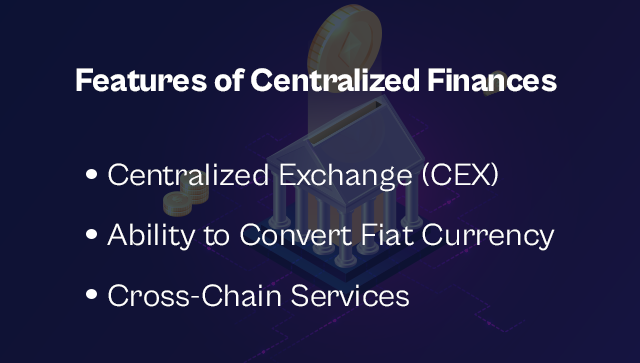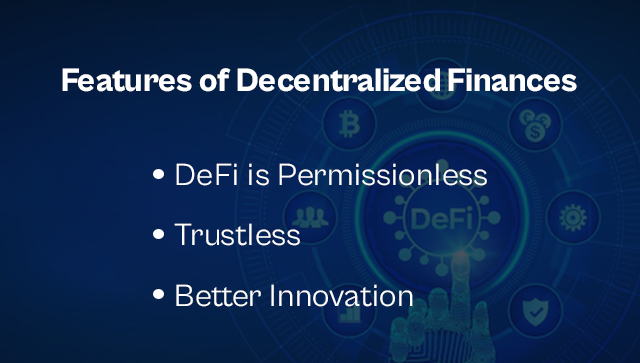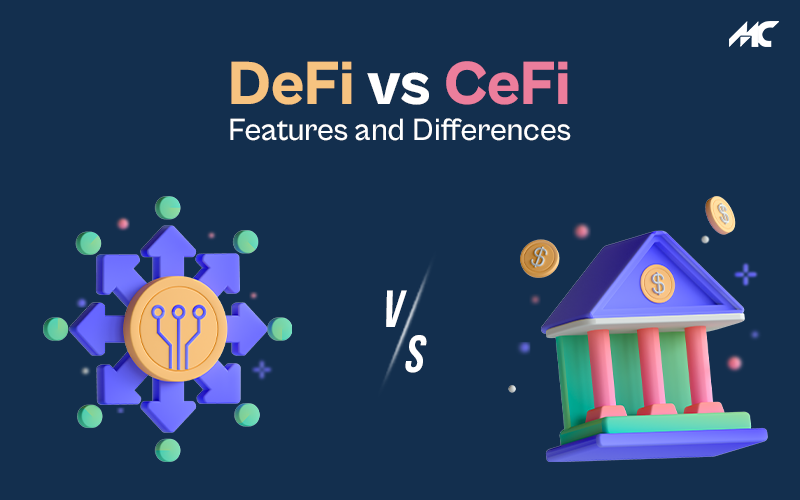DeFi vs CeFi: Features and Differences
Blockchain and cryptocurrencies have become vast domains for tech enthusiasts and investors. Traditionally, the finance industry has been dependent on established financial institutions for payment processing, lending, and borrowing.
However, with the rise of cryptocurrencies, there’s been a constant debate between decentralized finance (DeFi) and centralized finance (CeFi).
In this blog, we are going to draw a brief comparison between “DeFi vs CeFi” “centralized vs decentralized cryptocurrency” to understand their features and differences.
To understand the difference between these two mediums of finances, we have to understand both of them individually.
What is Meant by Centralized Finance (CeFi)?
Traditional financial institutions have been controlling the finance industry for hundreds of years. In fact, centralized finance was even used to trade cryptocurrencies. It provides strong control over the cryptocurrency industry to some specific authorities. In fact, all the funds are by a central exchange in CeFi. Thus, you don’t necessarily require a private key for getting access to your wallet.
The exchanges have the complete power to determine the coins that they list for trading and the fees required for trading from their exchange. In this form of Finance, you don’t actually own your cryptocurrencies while buying or selling from a centralized exchange. Moreover, there will be certain rules imposed by the exchange. Thus, you must abide by the rules to retain your holdings on the exchange.
What is Meant by Decentralized Finance (DeFi)?
Decentralized finance is all about openness and automation. In fact, no exchange or central authority is actually involved in processing the transactions in DeFi. Users can ensure complete automation in apps on a Blockchain platform. Moreover, DeFi provides better transparency and opportunity for users to participate in the network. Above all, decentralization is a great way of ensuring better financial inclusion for the people who are devoid of banking services.
DeFi allows us to create an open-source, transparent, and permissionless financial service ecosystem. Thus, users can expect services like borrowing, crypto lending, asset storage, yield farming, and more. Ultimately, the users have full control over their assets and get a key to access their choice of wallet. Above all, decentralized applications (dApps) are used by the users who want to take advantage of DeFi services and the power of a robust Blockchain platform.
DeFi vs CeFi: Comparison
Both of the finances are quite different from each other. In fact, both of them are useful for different use cases. DeFi is more user-centric to provide diverse services. Whereas, CeFi is meant for businesses for managing funds and conducting business services.
Let’s discuss the features of DeFi vs CeFi;
Features of Centralized Finances

-
Centralized Exchange (CEX)
CeFi works with a traditional cryptocurrency exchange like Binance, Coinbase, or Kraken. Here, the users are able to send or exchange funds with the help of an internal account. Although the funds are kept on the exchange the users actually don’t have access to their funds. Thus, cybercriminals are more vulnerable to security threats or exchange failure.
Centralized exchanges are often the common targets of security attacks and information leaks. For this reason, the large exchanges have to provide proper customer service to assist the customers throughout their financial trading journey. Ultimately, the customer is able to get some satisfaction and comfort to get the assurance their funds are in good hands.
-
Ability to Convert Fiat Currency
Due to the supervision of central authorities, it becomes possible to convert fiat currency into cryptocurrency and vice versa. Above all, the conversion of a fiat currency can only take place under the supervision of a centralized entity. Thus, it is not possible to convert Fiat currency with the help of DeFi. Above all, centralized finance becomes more convenient and streamlined when it comes to fiat currency conversion and customer experience.
-
Cross-Chain Services
A CeFi platform is known for supporting trade in BTC, XRP, Ether, LTC, and other prominent coins issued on various blockchain platforms. However, it might not be possible to execute cross-chain swaps between these currencies due to the latency and complexity of these tokens.
CeFi is effective in getting the custody of funds from various chains. This provides a big benefit to the investors who want to bank on the highest market-cap coins. In fact, the coins can exist on multiple independent blockchains and don’t implement with interoperability standards.
Features of Decentralized Finances


-
DeFi is Permissionless
Unlike Centralized Finances, DeFi is completely permissionless. In fact, the users can directly access the services with the help of a wallet without even providing their personal information. Whereas, in CeFi, the users will need to fulfil a KYC process to gain access to services. Moreover, they are also required to share their personal information or deposit funds to their accounts.
DeFi allows the users to participate and openly access the services in the Blockchain without any barrier or discrimination. Thus, DeFi takes full advantage of Blockchain technology. The users are able to freely conduct their activities without worrying about restrictions and privacy issues. Moreover, they are able to get a higher degree of accessibility and have better collaboration opportunities with the community.
-
Trustless
This is a major benefit of using Decentralized Finances in a Blockchain network. In fact, the users don’t have to trust the service will perform as claimed. Users can just authenticate a DeFi service to perform as intended by analyzing its code and with the help of external tools. Ultimately, tools like Etherscan are very effective in identifying if a transaction was executed in the right way.
-
Better Innovation
We all know that a restrictive environment creates a hindrance to innovation and change. For this reason, DeFi is known for being suitable for faster innovation. A Decentralized Finance ecosystem is highly relevant for experimenting with new capabilities and features. In fact, traditional financial institutions like banks have also realised the potential of the robustness of the DeFi space. It has been a more cost-effective way of delivering alternative ways to solve a problem.
Problems with CeFi
Unsustainable Yields
CeFi is known for providing high yields to investors. This is achieved by encouraging the investors to make investments in risky protocols. However, if these protocols are collapsed, the CeFi lenders might not be able to keep up with the yields.
Lack of Transparency
Transparency is a major problem with CeFi because it has been controlled by private companies and government authorities. Thus, there’s anyone in higher authority can alter or manipulate the data present on the blockchain.
Under-Collateralized Lending
CeFi lenders might offer customized lending terms. However, they might be under-collateralized or even non-collateralized lending. Thus, the investor might land higher financial risks. In contrast, borrowing in DeFi is usually over-collateralized.
Problems with DeFi
Scalability is Limited
DeFi is certainly a better option for improving financial inclusion in our economy. However, DeFi projects tend to face difficulties in scalability. It becomes quite challenging to scale the host Blockchain from different perspectives. Moreover, it might take a longer period of time for processing DeFi transactions.
Huge Uncertainty
The high uncertainty with DeFi could provide both advantages and disadvantages to the end users. For instance, if you are building a DeFi project, it will automatically inherit instabilities from the host Blockchain. Suppose you are building your project on the Ethereum blockchain, then your solution will also inherit the problems associated with the Ethereum platform.
Shared Responsibilities
A Blockchain mechanism works with shared responsibilities. In fact, every participant on a Blockchain is responsible for its proper functioning. A DeFi project won’t be taking the responsibility for mistakes and there won’t be any customer support. In fact, DeFi is just meant to remove the intermediaries who usually take commissions.
The users themselves are responsible for their funds and assets. Thus, you will need the right tools to prevent the possibility of human mistakes and errors. A FinTech app development company can assist you in finding and implementing the right tools.
To draw a more understandable comparison between CeFi and DeFi, we can take the help of this chart.
| Category | DeFi | CeFi |
| Custody of Funds | The user has complete control over his/her funds. | The user doesn’t have control over funds. Instead, it is managed by a central authority. |
| Services Available | Lending, borrowing, payments, trading. | Borrowing, fiat to crypto conversion, trading, lending, payments. |
| Required Personal Information | Requires proof of work | Requires complete user information for KYC. |
| Security Measures | Not accountable for funds. | Might be vulnerable if the exchange security collapses. |
| Market Capitalization | $16 billion* | $324 billion* |
| Customer Service | There’s no customer support | Support is provided in major exchanges. |
| Risk Factor | The security of the solution depends on the technology that you have implemented. | The central exchanges will be responsible for the security of the solution. |
Comparing Individual Properties of DeFi and CeFi
These are the common attributes which will help us to understand the difference between “DeFi vs CeFi”.


-
Public Verifiability
CeFi is not known for being transparent. In fact, it doesn’t allow the users to check and verify the execution of changes on the ledger. In contrast, DeFi is non-custodial, which means anyone present on the Blockchain can verify the integrity and genuineness of the data. This high level of transparency in DeFi technology creates better trust among the participants.
-
Atomicity
A Blockchain network allows users to have multiple sequential actions. These actions might include various financial transactions. The combination of actions is known as atomic, which means that either the transaction will complete successfully or fail collectively. This atomicity is not present in CeFi but we can use some expensive legal agreements to implement atomicity in CeFi.
-
Deploying and Developing Anonymously
It is a well-known fact that centralized finance provides less anonymity than decentralized finances. The majority of the DeFi projects are built and managed by anonymous individuals. In fact, Bitcoin’s founder/s still remain unknown to this date. Moreover, DeFi applications can even work without a front-end, making people directly interact with the smart contracts. In contrast, this is not possible with CeFi because of regulations and restrictions.
-
Custody of Funds and Assets
DeFi users are able to directly control their funds and assets anytime without being monitored or affected by a central authority. Thus, the users don’t have to wait for any bank or financial institution to open its operations. Users just have to be technically literate to understand the technological hazards associated with DeFi. In traditional CeFi exchanges, the business owners are responsible for keeping the cryptocurrency assets.
-
Trading with Cryptocurrencies
The centralized exchanges are built with traditional protocols of financial services. Thus, there are certain limitations when it comes to trading with cryptocurrencies. Whereas, decentralized exchanges function in an entirely different way. They work by matching the counterpart in a transaction with the help of automated market-maker, protocols.
-
Transaction Costs
Financial institutions depending on CeFi would often charge extra for providing transaction services. The transactions are often organized by a business or a government authority. In contrast, DeFi transactions on a Blockchain take place without the need for an intermediary. Moreover, DeFi also supports Anti-Money Laundering (AML) verifications for users.
-
Market Hours
CeFi solutions are highly susceptible to experiencing outages. In fact, they operate for limited hours and only for certain days of the week. Thus, this creates latency in moving funds and showing real-time insights from the market. In a dynamic economy, it becomes important to have non-stop market hours to enable a smooth flow of funds and information. For this reason, DeFi markets are open throughout the day and seven days a week. Thus, users are able to have more flexibility when it comes to playing in the market.
-
Privacy Measures
It is a known fact that CeFi solutions require user data to operate. Thus, there are always some chances of privacy compromise with CeFi. Whereas, DeFi protocols provide better privacy preservation protocols to help users to secure their personal data and go anonymous. No central authority can intrude into your privacy when you are relying on DeFi.
-
Inflation
Inflation is often understood as the loss of a currency’s purchasing power. In Centralized Finance solutions, the banks have the power to print fiat money and inflation is often valued against the value of consumer products.
In Decentralized Finance solutions, the supply chain of cryptocurrencies might change anytime. Moreover, the majority of cryptocurrencies have a hard cap on their production. Therefore, there’s always some scarcity of cryptocurrencies. Moreover, cryptocurrencies with DeFi are less susceptible to inflation.
-
Cross-Chain Services
Despite being decentralized, major cryptocurrencies would need a CeFi exchange for effective trading. DeFi services usually do not support the trade between multiple tokens due to the complexity and delay of exchanges.
CeFi services are effective in resolving this problem by storing funds from various chains. Thus, CeFi is better when it comes to abiding by the interoperability rules.
-
Flexibility of Fiat Conversion
As we have discussed before, it takes the presence of a central authority to convert fiat currencies or vice versa. Thus, centralized finances are more flexible than decentralized finances for the effective conversion of fiat currency.
DeFi as an Extension of CeFi
We shouldn’t consider DeFi as a replacement for traditional CeFi. Instead, DeFi should be recognized as an extension of CeFi. It could not only just mimic CeFi services but also amplify them to the next level.
In fact, a prominent FinTech app development company would often rely on both DeFi vs CeFi while developing FinTech applications. Many financial institutions are linking DeFi and CeFi together to boost their efficiency.
Summing Up: DeFi vs CeFi
We have learned that both DeFi vs CeFi have their own advantages and disadvantages. However, businesses can significantly benefit by combining the best features of CeFi and DeFi. It would significantly help businesses to get started in the crypto world with their own special offerings.
Thus, you can also invest in FinTech app development and develop remarkable solutions with DeFi and CeFi. MobileCoderz is a prominent Fintech app development company with years of experience in developing both centralized and decentralized FinTech applications. Moreover, we have an extensive portfolio of clients from diverse industry verticals.
-

 Mobilecoderz Awarded as India’s Best iPhone App Development Company by Clutch
Mobilecoderz Awarded as India’s Best iPhone App Development Company by Clutch -

 How Much Does It Cost to Develop a SaaS Application?
How Much Does It Cost to Develop a SaaS Application? -

 Mobilecoderz recognized as the Top App Development Company in Saudi Arabia by GoodFirms
Mobilecoderz recognized as the Top App Development Company in Saudi Arabia by GoodFirms




